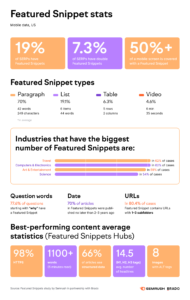In the changing world of SEO, it’s important to stay updated so your content gets seen by more people. A really important thing in SEO is Google’s featured snippets. These are short pieces of information that show up at the top of search results. They give users fast answers to their questions.
Optimizing for Google’s featured snippets requires a strategic approach that combines content optimization, technical implementation, and continuous refinement.
By understanding the various types of featured snippets and tailoring your content to address specific user queries, you can increase your chances of claiming the position zero spot in search engine results.
But note that the ultimate goal is to provide users with valuable, concise answers while positioning your brand as an authority in your field. With the right techniques and dedication, you can successfully optimize your content for Google’s featured snippets and reap the benefits of increased visibility and traffic.
This guide will delve into the complexities of optimizing for Google’s featured snippets and share strategies to help your content claim that coveted position.
Our Approach To Optimize For Google’s Featured Snippets The right way
Before diving into optimization techniques, let’s explain our analysis and understanding on what featured snippets are and why they matter.
What Are Featured Snippets?
Google’s Featured Snippets are selected search results that appear at the top of Google’s search engine results page (SERP) in a “position zero” placement. They aim to provide users with direct answers to their queries, eliminating the need to click through to a specific website.
Here is an example of a how a feature snippet look like in search results.

Why Are Featured Snippets Important?
Featured snippets hold significant importance due to their ability to provide users with quick and concise answers directly on the search results page. Here’s why they are important.
Here are the top 5 reasons why you should consider Featured snippets,
- Enhanced Visibility: Featured snippets appear at the top of search results, capturing users’ attention and increasing your website’s visibility even if it’s not the first organic result.
- Higher Click-Through Rates: The prominence of featured snippets can lead to higher click-through rates as users are more likely to click on a result that directly answers their query.
- Authority and Trust: Attaining a featured snippet position positions your website as an authoritative source in your niche, building trust among users seeking reliable information.
- Improved User Experience: Users appreciate quick and relevant answers. Featured snippets provide a concise response, enhancing user experience by reducing the need to click on multiple links.
- Brand Exposure: If your content consistently appears in featured snippets, users become familiar with your brand as a knowledgeable source, leading to increased brand exposure.
Types of Featured Snippets
There are several types of featured snippets, each catering to different types of user queries:
1. Paragraph Snippets
These are concise explanations that provide direct answers to users’ questions. They are particularly effective for “how,” “what,” and “why” queries.
2. List Snippets
List snippets present information in a numbered or bulleted list format. They are suitable for queries related to steps, tips, or rankings.
3. Table Snippets
Table snippets display data in a tabular format, making them ideal for queries that require comparison or data representation.
4. Video Snippets
Video snippets feature a video thumbnail from YouTube, providing users with video content directly within the search results.
Examples of Featured Snippets
Here are the examples of featured snippets
Definition Snippet:
Query: “What is photosynthesis?”
Featured Snippet: Provides a concise definition of photosynthesis and a brief explanation, often sourced from a high-authority website.
List Snippet:
Query: “Benefits of regular exercise”
Featured Snippet: Displays a list of benefits of regular exercise, usually in a bullet-point format, extracted from a relevant article.
Table Snippet:
Query: “Comparison of iPhone models”
Featured Snippet: A table comparing different iPhone models with specifications, prices, and other details, sourced from a reliable product comparison webpage.
Below are several analyses conducted on Featured snippets as part of market studies:

Image source Semrush
Optimizing for Featured Snippets
Now, let’s explore effective strategies to optimize your content for featured snippets:
1. Identify Snippet Opportunities
Conduct keyword research to identify queries that frequently trigger featured snippets. Tools like Ahrefs, SEMrush, and Moz can help you uncover these opportunities.
- Identifying snippet opportunities involves finding keywords that often trigger Google’s featured snippets.
- Begin with keyword research to discover popular terms in your niche. Search for your target keywords on Google to see existing featured snippets and understand the content format.
- Focus on question-based queries (who, what, where, when, why, how) and structure your content with clear headings, schema markup, and concise answers. Use schema markup like “How-to” or “FAQ” to enhance eligibility.
- Craft meta descriptions that concisely answer queries and leverage the “People Also Ask” box for related questions. Employ descriptive subheadings, optimize images and videos, and ensure well-organized content.
2. Structure Your Content
Organize your content with clear headings, subheadings, and bullet points. This makes it easier for search engines to understand the structure of your content.
Start with a brief introduction that outlines the main topic and its importance. This sets the context for your readers.
Use Subheadings:
Use descriptive and relevant subheadings to break your content into manageable sections.
For example:
-
- “Understanding the Importance of Keyword Research”
- “Steps to Conduct Effective Keyword Research”
- “Top Keyword Research Tools to Consider”
Use Bullet Points or Numbered Lists:
Presenting information in lists makes it easier for readers to grasp key points.
For instance:
-
- “Benefits of Using SEO Tools:”
- Improved keyword targeting
- Enhanced website performance
- Competitive analysis
Include Visual Aids:
Incorporate images, infographics, charts, and videos to complement your content.
For instance:
-
- Include a graph illustrating the growth of website traffic after implementing SEO techniques.
Examples and Case Studies:
Share real-life examples or case studies to illustrate your points.
For example:
-
- “Case Study: How Company X Increased Conversion Rate by 30% with On-Page SEO”
Data and Statistics:
Incorporate relevant data and statistics to support your claims.
For example:
-
- “According to a recent study, websites that appear in the top three search results receive over 75% of clicks.”
3. Craft Concise Answers
Provide concise answers to the query in question. Aim for around 40-60 words to match the typical length of featured snippets.
4. Use List Formats
For queries that ask for steps, tips, or rankings, use numbered or bulleted lists. This increases the likelihood of your content being selected as a list snippet.
5. Leverage Tables
If your content involves data comparison, consider presenting it in a table format. Search engines may choose your table to appear as a snippet.
6. Answer Common Questions
Identify frequently asked questions related to your niche and provide detailed answers. This improves the chances of your content being selected as a paragraph snippet.
Technical Optimization
Aside from content optimization, certain technical factors can enhance your chances of securing a featured snippet:
Technical optimization for Google featured snippets involves refining your content’s structure, using schema markup, crafting succinct answers, and utilizing appropriate HTML tags. This increases the likelihood of your content being selected for these informative search results.
1. Schema Markup
Implement schema markup on your content to provide clear context to search engines. This can increase the likelihood of your content being selected for snippets.
2. Meta Descriptions
Craft compelling meta descriptions that summarize your content. Search engines may use this content as the basis for featured snippets. Encourage reader engagement with a clear clickable call-to-action.
For Example:
- “Ready to boost your website’s visibility?
- Start implementing these SEO strategies!”
- Begin your journey towards better SEO practices by implementing these techniques today.
3. Page Speed
Page speed is a crucial factor in website performance and user experience. Ensure your website loads quickly, as page speed is a ranking factor that can influence your content’s chances of appearing as a featured snippet.
Monitor Your Snippets
Monitoring Google featured snippets is crucial to understand your performance, refining your content strategy, and maintaining a competitive edge.
Here are some tips to effectively monitor Google’s Featured Snippets:
- Regular Keyword Tracking: Use SEO tools to track the keywords for which you aim to attain featured snippets. Monitor changes in their featured snippet status and rankings.
- Set Up Google Alerts: Set up Google Alerts for specific queries related to your industry. This can help you receive notifications whenever there’s a change in featured snippet content.
- Monitor Competitors: Keep an eye on competitors’ content that appears in featured snippets. Analyze their strategies and identify opportunities for improvement.
- Use Rank Tracking Tools: Utilize rank tracking tools that specifically focus on featured snippets. These tools provide insights into which snippets you currently own and which ones your competitors have.
- Analyze User Intent: Understand the intent behind the query that triggers a featured snippet. Tailor your content to match that intent precisely.
- Optimize for Voice Search: Featured snippets are frequently used in voice search results. Optimize your content to match the conversational language used in voice queries.
- Monitor Across Devices: Featured snippets are displayed differently on desktop and mobile devices. Ensure that your content is optimized for both platforms.
By consistently monitoring featured snippets, adapting your content strategy, and staying informed about industry trends, you can improve your chances of obtaining and retaining these valuable search result features.





